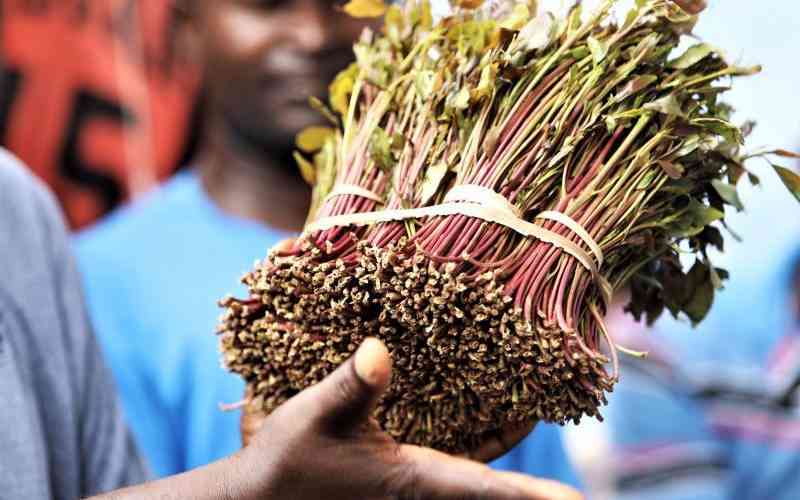By Maore Ithula
Many decades after putting miraa, a useless wild herb before then, into economic use, the people of Nyambene District have now turned another weed into an economic asset.
The weed, the ‘false’ banana or iuku, grows near forests and is a close cousin of the banana plant. It is mainly used for landscaping in upmarket estates locally and in Europe.
But in Igembe where miraa is the dominant cash crop, the broad leaves of the truculent plant are precious to miraa traders as a wrapping material that best preserves the twigs while on transit to markets.
Iuku is also called the monster Abyssinian banana while scientifically, it is referred to as Ensete vetricosum.
The plant’s production and sale is mainly a women’s affair while the trade and ownership of miraa farms is traditionally the man’s domain. Indeed, women are making a fortune every week by selling the iuku leaves and barks.
For instance, Teresia Kabuli sells an average of 200 leaves of the plant every day at Laare market.
Cater for daily needs
Each leaf retails at Sh5 during the wet spell and Sh10 during the dry season.
The grandmother says she uses her earnings to cater for her daily needs and has some more left over for her savings, which include women’s chamas.
Jennifer Kananu is more advanced in the trade. Besides selling the leaves, Kananu also trades in dry barks of the plant, which are used for tying miraa twigs in bundles and later tying the wrapped bundles.
The lifespan of iuku is about two years, and the more one harvests the leaves and bark, the longer the life of the plant.
During the dry spell last year, the plants dried up and the traders had to get supplies from Mt Kenya and the Nyambene Hill ranges from where the plant is thought to have originated.
But getting the leaves from a protected area is a long and tedious process that was especially tough for women.
Some people were jailed for illegally picking the leaves. To harvest these plants from the area, one requires licence from the Forestry Department. Yet, this plant has no other use. It is not even fodder for livestock.
Stay informed. Subscribe to our newsletter
To pick leaves
In case of another dry spell, Kabuli is ready with her renewable permit to harvest the leaves from the hills.
The document is free piece of paper declaring that one is not out to conduct illegal logging but to pick leaves, an exercise that is not harmful to the environmental health of the forests.
"Sale of these leaves is my only source of income. I have to be compliant all the time otherwise my family will suffer," says Kabuli.
The false banana grows up to 12m. It originates from mountainous regions of Ethiopia which makes it more cold tolerant than true bananas.
It has bright green, paddle shaped leaves with red or green midrib (the thick central vein that runs from the base of a leaf to its apex).
 The Standard Group Plc is a
multi-media organization with investments in media platforms spanning newspaper
print operations, television, radio broadcasting, digital and online services. The
Standard Group is recognized as a leading multi-media house in Kenya with a key
influence in matters of national and international interest.
The Standard Group Plc is a
multi-media organization with investments in media platforms spanning newspaper
print operations, television, radio broadcasting, digital and online services. The
Standard Group is recognized as a leading multi-media house in Kenya with a key
influence in matters of national and international interest.
 The Standard Group Plc is a
multi-media organization with investments in media platforms spanning newspaper
print operations, television, radio broadcasting, digital and online services. The
Standard Group is recognized as a leading multi-media house in Kenya with a key
influence in matters of national and international interest.
The Standard Group Plc is a
multi-media organization with investments in media platforms spanning newspaper
print operations, television, radio broadcasting, digital and online services. The
Standard Group is recognized as a leading multi-media house in Kenya with a key
influence in matters of national and international interest.









